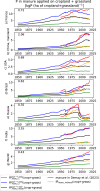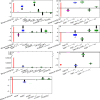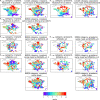A global dataset on phosphorus in agricultural soils
- PMID: 38167392
- PMCID: PMC10762041
- DOI: 10.1038/s41597-023-02751-6
A global dataset on phosphorus in agricultural soils
Abstract
Numerous drivers such as farming practices, erosion, land-use change, and soil biogeochemical background, determine the global spatial distribution of phosphorus (P) in agricultural soils. Here, we revised an approach published earlier (called here GPASOIL-v0), in which several global datasets describing these drivers were combined with a process model for soil P dynamics to reconstruct the past and current distribution of P in cropland and grassland soils. The objective of the present update, called GPASOIL-v1, is to incorporate recent advances in process understanding about soil inorganic P dynamics, in datasets to describe the different drivers, and in regional soil P measurements for benchmarking. We trace the impact of the update on the reconstructed soil P. After the update we estimate a global averaged inorganic labile P of 187 kgP ha-1 for cropland and 91 kgP ha-1 for grassland in 2018 for the top 0-0.3 m soil layer, but these values are sensitive to the mineralization rates chosen for the organic P pools. Uncertainty in the driver estimates lead to coefficients of variation of 0.22 and 0.54 for cropland and grassland, respectively. This work makes the methods for simulating the agricultural soil P maps more transparent and reproducible than previous estimates, and increases the confidence in the new estimates, while the evaluation against regional dataset still suggests rooms for further improvement.
© 2024. The Author(s).
Conflict of interest statement
The authors declare no competing interests.
Figures














References
-
- Kvakić M, 2018. Quantifying the Limitation to World Cereal Production Due To Soil Phosphorus Status. Glob. Biogeochem. Cycles. - DOI
-
- Yang X, Post WM, Thornton PE, Jain A. The distribution of soil phosphorus for global biogeochemical modeling. Biogeosciences. 2013;10:2525–2537. doi: 10.5194/bg-10-2525-2013. - DOI
-
- Achat DL, Pousse N, Nicolas M, Brédoire F, Augusto L. Soil properties controlling inorganic phosphorus availability: general results from a national forest network and a global compilation of the literature. Biogeochemistry. 2016;127:255–272. doi: 10.1007/s10533-015-0178-0. - DOI
Publication types
LinkOut - more resources
Full Text Sources
Research Materials
Miscellaneous

